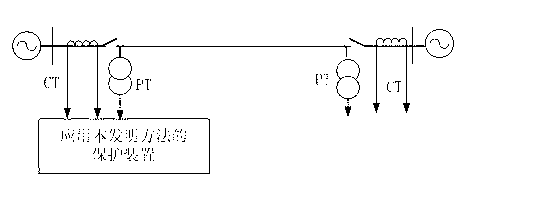Line single-phase earthing fault single-end ranging method realized by utilizing voltage drop imaginary part characteristics
A single-phase-to-ground fault, single-ended ranging technology, applied in the fault location and other directions, can solve the problems of fault location failure, high sampling rate requirements, and impact of ranging accuracy.
- Summary
- Abstract
- Description
- Claims
- Application Information
AI Technical Summary
Problems solved by technology
Method used
Image
Examples
Embodiment Construction
[0016] The technical solution of the present invention will be further described in detail according to the accompanying drawings.
[0017] figure 1 It is a schematic diagram of the line transmission system applying the present invention. figure 1 Among them, PT is a voltage transformer, and CT is a current transformer. The protection device samples the voltage waveform of the voltage transformer PT and the current waveform of the current transformer CT at the transmission line protection installation to obtain the instantaneous value of voltage and current, and uses the Fourier algorithm to calculate the fault phase voltage at the transmission line protection installation Fault phase negative sequence voltage fault phase current and zero sequence current As an input; where, φ = A, B, C phase.
[0018] The protection device uses the transmission line to protect the fault phase voltage at the installation Fault phase negative sequence voltage fault phase current ...
PUM
 Login to View More
Login to View More Abstract
Description
Claims
Application Information
 Login to View More
Login to View More - R&D
- Intellectual Property
- Life Sciences
- Materials
- Tech Scout
- Unparalleled Data Quality
- Higher Quality Content
- 60% Fewer Hallucinations
Browse by: Latest US Patents, China's latest patents, Technical Efficacy Thesaurus, Application Domain, Technology Topic, Popular Technical Reports.
© 2025 PatSnap. All rights reserved.Legal|Privacy policy|Modern Slavery Act Transparency Statement|Sitemap|About US| Contact US: help@patsnap.com



